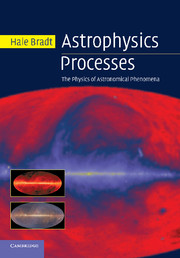Book contents
- Frontmatter
- Contents
- List of figures
- List of tables
- Preface
- Acknowledgments
- Also by the author
- 1 Kepler, Newton, and the mass function
- 2 Equilibrium in stars
- 3 Equations of state
- 4 Stellar structure and evolution
- 5 Thermal bremsstrahlung radiation
- 6 Blackbody radiation
- 7 Special theory of relativity in astronomy
- 8 Synchrotron radiation
- 9 Compton scattering
- 10 Hydrogen spin-flip radiation
- 11 Dispersion and Faraday rotation
- 12 Gravitational lensing
- Credits, further reading, and references
- Glossary
- Appendix: Units, symbols, and values
- Index
7 - Special theory of relativity in astronomy
Published online by Cambridge University Press: 05 June 2012
- Frontmatter
- Contents
- List of figures
- List of tables
- Preface
- Acknowledgments
- Also by the author
- 1 Kepler, Newton, and the mass function
- 2 Equilibrium in stars
- 3 Equations of state
- 4 Stellar structure and evolution
- 5 Thermal bremsstrahlung radiation
- 6 Blackbody radiation
- 7 Special theory of relativity in astronomy
- 8 Synchrotron radiation
- 9 Compton scattering
- 10 Hydrogen spin-flip radiation
- 11 Dispersion and Faraday rotation
- 12 Gravitational lensing
- Credits, further reading, and references
- Glossary
- Appendix: Units, symbols, and values
- Index
Summary
What we learn in this chapter
Albert Einstein postulated that the speed of light has the same value in any inertial frame of reference or, equivalently, that there is no preferred frame of reference. The consequence of this postulate is the special theory of relativity, which yields nonintuitive relations between measurements in different inertial frames of reference. We demonstrate the Lorentz transformations for space and time (x, t) and the compact and invariant four-vector formulation. From this, the four-vectors for momentum-energy (p, U) and wave propagation-frequency (k,ω) are formed, and these in turn yield the associated Lorentz transformations. The transformations for electric and magnetic field vectors are also presented. Examples of each type of transformation are given. The relativistic Doppler shift of wavelength or frequency is derived from time dilation and also directly from the k, ω transformations. The latter yield the transformation of radiation direction (aberration) from one inertial frame to another. Stellar aberration explains the displaced celestial positions of stars due to the earth's motion about the sun.
Astrophysical jets often emerge from objects that are accreting matter such as protostars, stellar black holes in binary systems, and active galactic nuclei (AGN) of galaxies. With our special-relativity tools, we study three aspects of the jet phenomenon: the beaming of radiation from objects traveling near the speed of light, the associated Doppler boosting of intensity, and superluminal motion. […]
- Type
- Chapter
- Information
- Astrophysics ProcessesThe Physics of Astronomical Phenomena, pp. 233 - 289Publisher: Cambridge University PressPrint publication year: 2008



